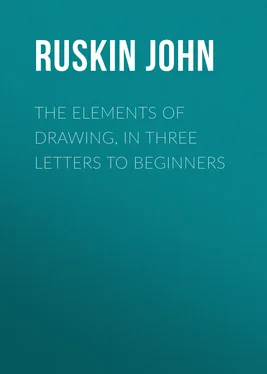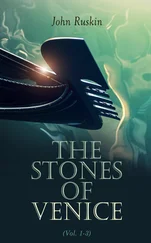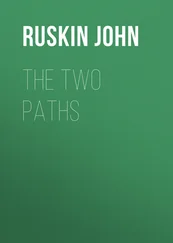John Ruskin - The Elements of Drawing, in Three Letters to Beginners
Здесь есть возможность читать онлайн «John Ruskin - The Elements of Drawing, in Three Letters to Beginners» — ознакомительный отрывок электронной книги совершенно бесплатно, а после прочтения отрывка купить полную версию. В некоторых случаях можно слушать аудио, скачать через торрент в формате fb2 и присутствует краткое содержание. Жанр: foreign_antique, foreign_home, literature_19, visual_arts, на английском языке. Описание произведения, (предисловие) а так же отзывы посетителей доступны на портале библиотеки ЛибКат.
- Название:The Elements of Drawing, in Three Letters to Beginners
- Автор:
- Жанр:
- Год:неизвестен
- ISBN:нет данных
- Рейтинг книги:4 / 5. Голосов: 1
-
Избранное:Добавить в избранное
- Отзывы:
-
Ваша оценка:
- 80
- 1
- 2
- 3
- 4
- 5
The Elements of Drawing, in Three Letters to Beginners: краткое содержание, описание и аннотация
Предлагаем к чтению аннотацию, описание, краткое содержание или предисловие (зависит от того, что написал сам автор книги «The Elements of Drawing, in Three Letters to Beginners»). Если вы не нашли необходимую информацию о книге — напишите в комментариях, мы постараемся отыскать её.
The Elements of Drawing, in Three Letters to Beginners — читать онлайн ознакомительный отрывок
Ниже представлен текст книги, разбитый по страницам. Система сохранения места последней прочитанной страницы, позволяет с удобством читать онлайн бесплатно книгу «The Elements of Drawing, in Three Letters to Beginners», без необходимости каждый раз заново искать на чём Вы остановились. Поставьте закладку, и сможете в любой момент перейти на страницу, на которой закончили чтение.
Интервал:
Закладка:
71. Observe, on the other hand, that, however white an object may be, there is always some small point of it whiter than the rest. You must therefore have a slight tone of gray over everything in your picture except on the extreme high lights; even the piece of white paper, in your subject, must be toned slightly down, unless (and there are thousand chances against its being so) it should all be turned so as fully to front the light. By examining the treatment of the white objects in any pictures accessible to you by Paul Veronese or Titian, you will soon understand this. 17
72. As soon as you feel yourself capable of expressing with the brush the undulations of surfaces and the relations of masses, you may proceed to draw more complicated and beautiful things. 18And first, the boughs of trees, now not in mere dark relief, but in full rounding. Take the first bit of branch or stump that comes to hand, with a fork in it; cut off the ends of the forking branches, so as to leave the whole only about a foot in length; get a piece of paper the same size, fix your bit of branch in some place where its position will not be altered, and draw it thoroughly, in all its light and shade, full size; striving, above all things, to get an accurate expression of its structure at the fork of the branch. When once you have mastered the tree at its armpits , you will have little more trouble with it.
73. Always draw whatever the background happens to be, exactly as you see it. Wherever you have fastened the bough, you must draw whatever is behind it, ugly or not, else you will never know whether the light and shade are right; they may appear quite wrong to you, only for want of the background. And this general law is to be observed in all your studies: whatever you draw, draw completely and unalteringly, else you never know if what you have done is right, or whether you could have done it rightly had you tried. There is nothing visible out of which you may not get useful practice.
74. Next, to put the leaves on your boughs. Gather a small twig with four or five leaves on it, put it into water, put a sheet of light-colored or white paper behind it, so that all the leaves may be relieved in dark from the white field; then sketch in their dark shape carefully with pencil as you did the complicated boughs, in order to be sure that all their masses and interstices are right in shape before you begin shading, and complete as far as you can with pen and ink, in the manner of Fig. 6
Конец ознакомительного фрагмента.
Текст предоставлен ООО «ЛитРес».
Прочитайте эту книгу целиком, купив полную легальную версию на ЛитРес.
Безопасно оплатить книгу можно банковской картой Visa, MasterCard, Maestro, со счета мобильного телефона, с платежного терминала, в салоне МТС или Связной, через PayPal, WebMoney, Яндекс.Деньги, QIWI Кошелек, бонусными картами или другим удобным Вам способом.
1
Or, more accurately, appears to be so, because any one can see an error in a circle.
2
If the student is fond of architecture, and wishes to know more of perspective than he can learn in this rough way, Mr. Runciman (of 49 Acacia Road, St. John's Wood), who was my first drawing-master, and to whom I owe many happy hours, can teach it him quickly, easily, and rightly. [Mr. Runciman has died since this was written: Mr. Ward's present address is Bedford Chambers, 28 Southampton Street, Strand, London, W.C.]
3
( N.B. —This note is only for the satisfaction of incredulous or curious readers. You may miss it if you are in a hurry, or are willing to take the statement in the text on trust.)
The perception of solid Form is entirely a matter of experience. We see nothing but flat colors; and it is only by a series of experiments that we find out that a stain of black or gray indicates the dark side of a solid substance, or that a faint hue indicates that the object in which it appears is far away. The whole technical power of painting depends on our recovery of what may be called the innocence of the eye ; that is to say, of a sort of childish perception of these flat stains of color, merely as such, without consciousness of what they signify,—as a blind man would see them if suddenly gifted with sight.
For instance: when grass is lighted strongly by the sun in certain directions, it is turned from green into a peculiar and somewhat dusty-looking yellow. If we had been born blind, and were suddenly endowed with sight on a piece of grass thus lighted in some parts by the sun, it would appear to us that part of the grass was green, and part a dusty yellow (very nearly of the color of primroses); and, if there were primroses near, we should think that the sunlighted grass was another mass of plants of the same sulphur-yellow color. We should try to gather some of them, and then find that the color went away from the grass when we stood between it and the sun, but not from the primroses; and by a series of experiments we should find out that the sun was really the cause of the color in the one,—not in the other. We go through such processes of experiment unconsciously in childhood; and having once come to conclusions touching the signification of certain colors, we always suppose that we see what we only know, and have hardly any consciousness of the real aspect of the signs we have learned to interpret. Very few people have any idea that sunlighted grass is yellow.
Now, a highly accomplished artist has always reduced himself as nearly as possible to this condition of infantine sight. He sees the colors of nature exactly as they are, and therefore perceives at once in the sunlighted grass the precise relation between the two colors that form its shade and light. To him it does not seem shade and light, but bluish green barred with gold.
Strive, therefore, first of all, to convince yourself of this great fact about sight. This, in your hand, which you know by experience and touch to be a book, is to your eye nothing but a patch of white, variously gradated and spotted; this other thing near you, which by experience you know to be a table, is to your eye only a patch of brown, variously darkened and veined; and so on: and the whole art of Painting consists merely in perceiving the shape and depth of these patches of color, and putting patches of the same size, depth, and shape on canvas. The only obstacle to the success of painting is, that many of the real colors are brighter and paler than it is possible to put on canvas: we must put darker ones to represent them.
4
Stale crumb of bread is better, if you are making a delicate drawing, than india-rubber, for it disturbs the surface of the paper less: but it crumbles about the room and makes a mess; and, besides, you waste the good bread, which is wrong; and your drawing will not for a long while be worth the crumbs. So use india-rubber very lightly; or, if heavily, pressing it only, not passing it over the paper, and leave what pencil marks will not come away so, without minding them. In a finished drawing the uneffaced penciling is often serviceable, helping the general tone, and enabling you to take out little bright lights.
5
What is usually so much sought after under the term "freedom" is the character of the drawing of a great master in a hurry, whose hand is so thoroughly disciplined, that when pressed for time he can let it fly as it will, and it will not go far wrong. But the hand of a great master at real work is never free: its swiftest dash is under perfect government. Paul Veronese or Tintoret could pause within a hair's breadth of any appointed mark, in their fastest touches; and follow, within a hair's breadth, the previously intended curve. You must never, therefore, aim at freedom. It is not required of your drawing that it should be free, but that it should be right; in time you will be able to do right easily, and then your work will be free in the best sense; but there is no merit in doing wrong easily.
Читать дальшеИнтервал:
Закладка:
Похожие книги на «The Elements of Drawing, in Three Letters to Beginners»
Представляем Вашему вниманию похожие книги на «The Elements of Drawing, in Three Letters to Beginners» списком для выбора. Мы отобрали схожую по названию и смыслу литературу в надежде предоставить читателям больше вариантов отыскать новые, интересные, ещё непрочитанные произведения.
Обсуждение, отзывы о книге «The Elements of Drawing, in Three Letters to Beginners» и просто собственные мнения читателей. Оставьте ваши комментарии, напишите, что Вы думаете о произведении, его смысле или главных героях. Укажите что конкретно понравилось, а что нет, и почему Вы так считаете.












